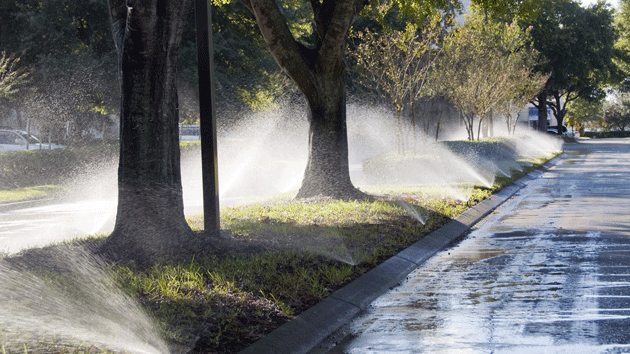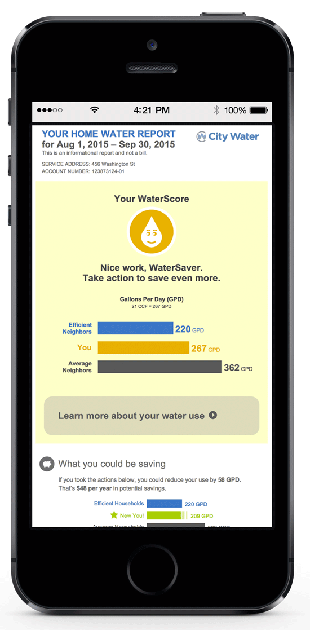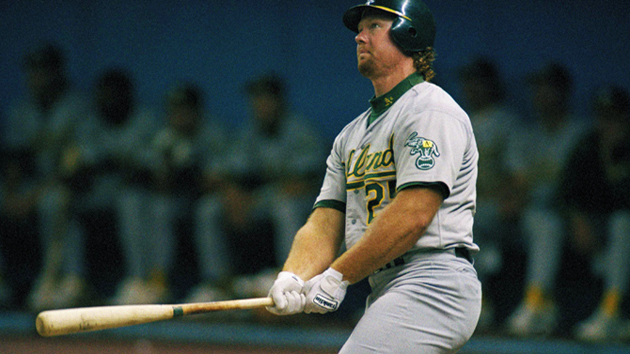
<a href="http://www.shutterstock.com/cat.mhtml?lang=en&language=en&ref_site=photo&search_source=search_form&version=llv1&anyorall=all&safesearch=1&use_local_boost=1&searchterm=lawn%20sprinkler&show_color_wheel=1&orient=&commercial_ok=&media_type=images&search_cat=&searchtermx=&photographer_name=&people_gender=&people_age=&people_ethnicity=&people_number=&color=&page=1&inline=64894774">John Panella</a>/Shutterstock
Last summer, one of my neighbors in Oakland, California, anonymously reported me to the East Bay Municipal Utility District for wasting water. I’d been dousing my front yard once or twice a week with arcing sprays from three huge Rain Bird sprinklers. Upon receiving written notice of the complaint, I called the utility and learned that I wasn’t actually violating water use rules, but the incident got me thinking. My ample vegetable garden was certainly green. Other yards the neighborhood were going brown. Did my neighbors think I was a water hog?
Confronted with a fourth year of drought and mandatory conservation measures, California has become a minefield of water politics. Snared in the web of blame are almond eaters, rice farmers, out-of-state grocery shoppers, rich people, China, and even hipsters. In cities and suburbs, the owners of dust-bowl lawns have squared off against their neighbors, including those of us who hand-water a few flowers or tomato plants at dusk while nervously looking over our shoulders. There’s a name for our fear: Drought shaming.
#DroughtShaming: Wealthy celebrities called out over lush California lawns http://t.co/slDVv3vLYw pic.twitter.com/DFIW5AcTAh
— CBC News (@CBCNews) May 21, 2015
Drought shaming isn’t just for celebrities or the rich. Smartphone apps such as Vizsafe, H20 Tracker, and DroughtShame allow users to snap and post geotagged photos of alleged water abuse. In Los Angeles, the infamous “water crusader” Tony Corcoran, a.k.a. YouTube’s Western Water Luv, bicycles around town videotaping homeowners with modestly sized green lawns who dare venture outside with a hose in hand:
Few water scolds take such a confrontational approach. Most don’t have the time to hunt down gushing sprinklers or the inclination to anger their neighbors. More common is the mild, polite sort of water shaming that a next-door neighbor directed at me last week, suggesting that I cover my garden in a layer of moisture-retaining bark mulch. I’d already felt pangs of guilt watching her irrigate her ragged flowers with a watering can filled with leftover dishwater.
With many California cities facing mandatory water cutbacks of 25 percent or more, it’s probably for the best that keeping up with the Joneses sometimes means not keeping up your yard. After all, most utility districts lack the will to cut off people’s water or the manpower to send out a fleet of water cops. And tiered water rates aren’t a silver bullet, either; they face new legal challenges and aren’t really steep enough to be all that effective. Ultimately, peer pressure is pretty much all we’ve got.
But here’s the problem: Even as progressive urbanites police each other’s water consumption, many California communities continue to treat water as a bottomless resource. In hose-happy suburbs such as Palm Desert, you’re still more likely to be treated as a pariah if you let your lawn die. Even in my own water district, some neighborhoods over the hills stubbornly cling to the East-Coast ideal of glistening Kentucky bluegrass and fluffy hydrangeas.
A tech startup has figured out how to bring a measure of constructive drought shaming to communities that were once impervious to it. San-Francisco-based WaterSmart sends out individualized reports that show water users how they stack up against their neighbors. Using insights gleaned from behavioral science, the reports essentially traffic in the same kind of peer pressure one might get from living in, say, a Berkeley enclave of graywater guerillas. The result is an average water savings of 5 percent—a big deal at a time when every drop counts.

The goal, says WaterSmart marketing director Jeff Lipton, is to coax out the feelings of tribal affinity that drive human behavior. “As we evolved, humans turned to the tribe and the behavior that was normal in that group as a survival mechanism,” he says. “There is sort of an existential threat of not fitting in. So it’s not shame and it’s not competition; I think it is a little more abstract than that.” And a lot more wonky: WaterSmart has a 19-page paper on this stuff, including the science of “goal setting,” “feedback,” and “injunctive norms.”
Though the WaterSmart interface seems simple, the calculations behind it are not. Two households of the same size can’t be expected to use the same amount of water if one has townhouse without a yard and the other a suburban spread on half an acre. That’s why WaterSmart combines utility data with property records to control for variables such as lot size, house size, microclimates, and the likely age of a home’s appliances. Users can further tweak their homes’ specs. If you have a large yard, WaterSmart will suggest installing drip irrigation and drought-tolerant plants. If you live in an old apartment building, it may prompt you to install a low-flow toilet or shower head.
Founded in 2009 by Peter Yolles, the director of water resource protection for The Nature Conservancy, WaterSmart grew slowly for several years, hindered, in part, by the low cost of water across the United States. Then came the drought. Last year, it tripled its customer base to 40 utilities in six states that represent 2 percent of all residential water meters in the country. It’s expecting a similar rate of growth this year. “I think we are at the very early stages of a transformation of the industry,” Lipton says.
WaterSmart still faces obstacles. Only about 20 percent of municipal utility districts employ advanced meters that can transmit residential usage in close to real-time, making it possible to frequently update customers on their water use. And glaring inefficiencies in agriculture, which uses 80 percent of California’s water, provide a convenient scapegoat for homeowners who’d prefer to keep running their taps.
Some users may interpret their favorable WaterSmart reports as an excuse to use more water. I asked the company to crunch the numbers for my house. Comparable dwellings, I learned, use an average of 336 gallons per day during the summer. In the summer of 2013, my house used 156 gallons per day. Behavioral scientists call the impulse that I might feel to use more water “the boomerang effect.” WaterSmart expects that it can keep the boomerangers in line with the virtual equivalent of a scowling neighbor, a frowning emoji.
Of course, the true dynamics of social pressure can be much more complicated. Last summer, my house used a whopping 591 gallons of water a day. I feel bad about this, but not that bad; most of the water went toward irrigating plugs of festuca rubra, a native grass that doesn’t need any summer water once it’s established. Now that it has taken root and I’ve mostly stopped watering it, I expect to easily best my neighbors’ water savings this year and still have an attractive lawn. Other than my fescue, the greenest thing in the neighborhood will be all the envy.













